Cinderella Pumpkins: How To Grow, Cook & Decorate With Them
Cinderella Pumpkins, also known as Rouge Vif d’Etampes, are a variety of pumpkins (Cucurbita pepo) often associated with the fairy tale Cinderella, due to their distinctive appearance. These pumpkins are native to France and have a flattened, deep orange color that resembles the pumpkin in many versions of the Cinderella story.

Characteristics Of A French Cinderella Pumpkin
- Shape: They are often described as flattened or squatty, almost like a pumpkin gently crushed from the top and bottom. This gives them a unique appearance and makes them stand out from the traditional round pumpkins.
- Color: The skin of Cinderella Pumpkins is a vibrant, reddish-orange color. The intense coloration sets them apart from other pumpkin varieties.
- Size: These pumpkins can vary in size, but they are typically medium-sized, making them a manageable option for cooking and decoration.

On my blog WM Design House, I may sometimes use affiliate links, which means a small commission is earned if you purchase via the link. The price will be the same whether you use the affiliate link or go directly to the vendor’s website using a non-affiliate link.
Cinderella vs. Fairytale Pumpkins
Cinderella Pumpkins and Fairytale Pumpkins are often associated with the world of fairytales and folklore. Still, they are distinct varieties of pumpkins with some differences in appearance and characteristics:

Cinderella Pumpkin (Rouge Vif d’Etampes):
- Appearance: Cinderella Pumpkins are known for their vibrant, deep red-orange skin and flattened, somewhat squat shape. They resemble the pumpkins often depicted in the Cinderella fairytale and are named after the famous character.
- Flavor and Use: Cinderella Pumpkins have a sweet, nutty flavor with a creamy texture. They are well-suited for sweet and savory dishes, including pies, soups, and roasting. The flavor is often milder and sweeter than other pumpkin varieties.

Fairytale Pumpkin (Musque de Provence):
- Appearance: Fairytale Pumpkins are a French heirloom variety known for their deeply ribbed, squat, flattened shape. They typically have brown or tan skin with some orange mottling.
- Flavor and Use: Fairytale Pumpkins have a sweet, rich flavor with dense, smooth-textured flesh. They are also versatile for sweet and savory dishes, similar to Cinderella Pumpkins. Some people find that the flavor of fairy tale pumpkins is more intense and concentrated.

In summary, the main differences between Cinderella Pumpkins and Fairytale Pumpkins are in their appearance, with Cinderella Pumpkins being known for their bright red-orange color and Fairytale pumpkins having brown or tan skin. In terms of flavor and culinary use, both varieties are prized for their sweet, nutty taste and suitability in a wide range of recipes. The choice between the two may be personal preference and the specific visual or culinary characteristics you want in your pumpkin.
What do you do with Cinderella Pumpkins?
Cinderella Pumpkins, renowned for their distinctive appearance and delightful, nutty sweetness, serve as versatile ingredients for many recipes. Moreover, their vibrant presence adds an enchanting touch to Fall decor.
Join me as I explore creative ways to make the most of your pumpkins.

Where to Buy Cinderella Pumpkins
You can typically find Cinderella Pumpkins in various places, especially during Fall. Here are some standard options for purchasing Cinderella Pumpkins:

- Local Farmers’ Markets: Local farmers’ markets are great places to find a variety of fresh and unique produce, including Cinderella Pumpkins. You can interact with local growers and get information about the pumpkins.
- Pumpkin Patches: Many pumpkin patches and farms offer Cinderella Pumpkins and other varieties. Visiting a pumpkin patch can be fun and festive to pick your own pumpkins.
- Grocery Stores: Some well-stocked grocery stores, particularly those focusing on fresh and seasonal produce, may carry Cinderella Pumpkins during the fall.
- Trader Joe’s: This is always my go-to for fresh pumpkins. They carry a variety of pumpkins at a reasonable price.
Can you grow your own Cinderella Pumpkin plants?
Growing Cinderella Pumpkins in your garden is a rewarding experience, and they can thrive under the right conditions. Here are the steps to grow beautiful pumpkins. You want to plant your seeds in the spring once the soil has warmed and the last frost has passed.
Step by Step Guide to Growing Cinderella Pumpkins
Select a Planting Area
Choose a sunny spot with well-draining soil. Like most pumpkin varieties, Cinderella Pumpkins require full sun to grow well.
Types of Soil
It is essential to have fertile soil. To improve soil fertility and drainage, prepare the soil by adding organic matter, like compost. Aim for loose soil to allow the roots to grow quickly.
Planting Seeds
These pumpkins can be grown from Cinderella Pumpkin seeds. Plant the seeds directly in the garden after the last frost date in your area. You can also start seeds indoors a few weeks before the last frost and transplant the seedlings later.
Spacing
It’s a good idea to space the seeds or seedlings about 3 to 5 feet apart in rows, allowing plenty of space for the large vines to spread.


Watering
Keep the soil consistently moist, but avoid over watering, which can lead to root rot. Water at the base of the plants keeps the foliage dry, which helps prevent diseases.
Fertilizing
Fertilize the plants with a balanced, all-purpose fertilizer when you plant them and then again when the first flowers appear. Follow the fertilizer’s instructions for application.
Mulch
Apply a layer of mulch around the base of the plants to help retain soil moisture, suppress weed growth, and maintain even soil temperatures.
Pruning Cinderella Pumpkin vines
You can prune the vines to encourage better air circulation and prevent the plants from taking over your garden. Trimming excessive foliage can also help the pumpkins receive more sunlight.
Pollination
Cinderella Pumpkins, like all pumpkins, require pollination to produce fruit. Bees and other pollinators will usually do the job. If you lack pollinators, you can hand-pollinate the flowers by transferring pollen from male to female flowers using a small brush or cotton swab.
Common diseases & Common Pests
Monitor your plants for pests and diseases. Common pumpkin pests include aphids, cucumber beetles, and squash bugs. Pumpkin plants can also be susceptible to powdery mildew, so spray to prevent it.
Harvesting
The Cinderella variety are typically ready for harvest when the skin turns a deep, vibrant red-orange and they reach the desired size (usually 10-15 pounds). Cut the pumpkins from the vine, leaving a few inches of stem attached for better storage.
Cure and Store
Allow the harvested pumpkins to cure in a warm, dry place for a week or two. This helps harden the skin and extend its shelf life. Store them in a cool, dry location with good air circulation.
Growing Cinderella Pumpkins can be a fun and rewarding gardening project. Following these steps and providing the right care will help you grow healthy and vibrant Cinderella Pumpkins to enjoy in your culinary creations and Fall decor.

Companion Planting:
Companion planting is when different plants are grown together to help each other grow better. This is important for these reasons:
- Pest Management: Some plants, when grown together, can help repel or deter common pests. This reduces the need for chemical pesticides and promotes natural pest control.
- Improved Pollination: Certain companion plants can attract pollinators like bees and butterflies, benefiting the overall health and yield of the garden.
- Enhanced Growth: Pairing plants strategically can lead to better growth and development. For example, taller plants may provide shade or support for shorter ones, leading to improved crop health.

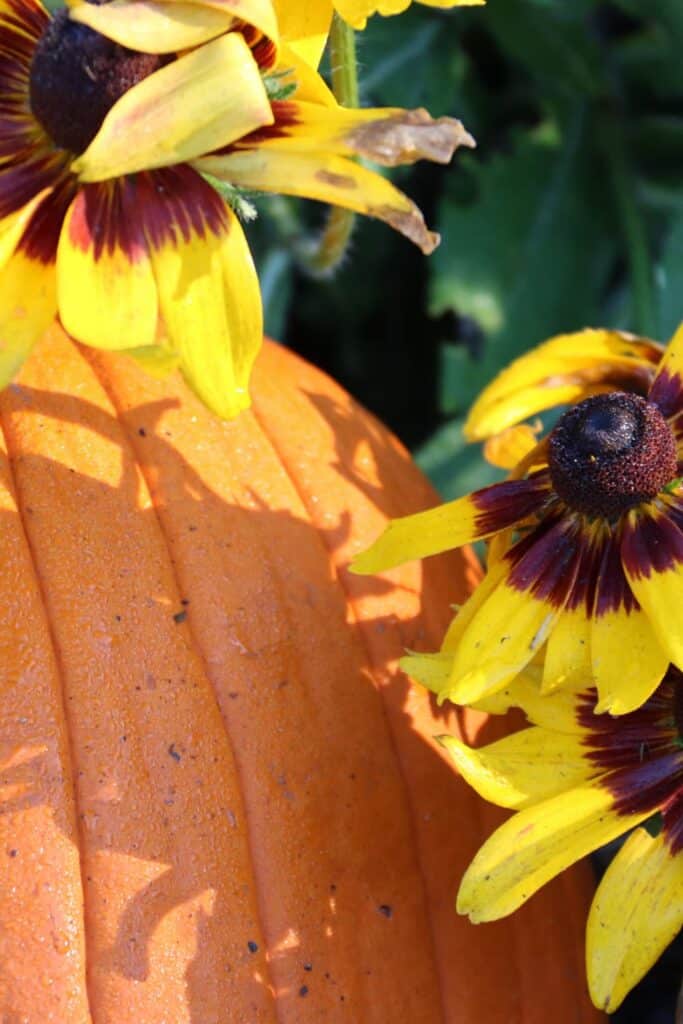
So what are the best plants to plant with Cinderella Pumpkins? Here are a list of just a few.
Companion Plant List
- Corn: Planting tall, sturdy corn near your pumpkin patch can provide natural trellis support for the sprawling pumpkin vines. Ensure you don’t shade the pumpkin plants too much with the corn.
- Beans: . Beans can provide vertical growth in your garden while also helping to fix nitrogen in the soil.
- Oregano and Dill: These herbs can deter pests like aphids and attract beneficial insects, making them good pumpkin companions.
- Onions and Garlic: These aromatic plants can help repel pests like aphids and squash bugs.
- Lettuce or Spinach: These leafy greens can be planted between pumpkin vines, utilizing the space while providing shade to the soil to help retain moisture.
- Sunflowers: Sunflowers can provide shade to the soil and attract pollinators.
Marigolds: Marigolds can help deter pests like aphids and nematodes, which can be problematic for pumpkin plants.
Nasturtiums: Nasturtiums can repel pests such as aphids and squash bugs while attracting beneficial insects like ladybugs that prey on garden pests.
Can you cook with Cinderella Pumpkins?
Fall is my favorite time of the year, as I love any pumpkin recipes. I particularly like to use Cinderella Pumpkins for cooking due to their sweet flavor. Here are just a few of my favorite ideas to make with pumpkin.


What Do Cinderella Pumpkins Taste Like?
As previously discussed, Cinderella Pumpkins have an excellent flavor. Sweet and nutty with a smooth and creamy texture, making them an excellent choice for various culinary applications. The taste is often milder and sweeter than other pumpkin varieties. When cooked, the flesh of Cinderella Pumpkins has a tender consistency and a rich, velvety quality, which makes it ideal for use in soups, pies, and other dishes.
Cinderella Pumpkin Recipes
One of my absolute favorites is this Cinderella Pumpkin Bundt Cake. Not only does it taste great, but it looks so pretty on the table.

- Pumpkin Pie: One of the most traditional uses for any pumpkin is to make a delicious pie. Cinderella Pumpkins’ sweet, orange flesh is perfect for this classic dessert.
- Pumpkin Soup: Cinderella Pumpkins can make a creamy texture and flavorful pumpkin soup. Add onions, garlic, and spices to create a delicious, comforting soup.
- Roasted Pumpkin: You can cut Cinderella Pumpkins into chunks, season them with herbs and spices, roast them in the oven, or throw a few slices on the grill.
- Pureed Pumpkin: Cinderella Pumpkins can be pureed and used in various recipes. You can use the puree in baking, such as pumpkin bread, muffins, or pancakes.
- Pumpkin Quick Breads: Pumpkin quick bread is a delightful, moist, spiced treat perfect for savoring fall flavors.
- Pumpkin Butter: Pumpkin butter is a sweet and spiced spread or condiment made from cooked and pureed pumpkin, often combined with sugar, spices (such as cinnamon, nutmeg, and cloves), and sometimes citrus zest or juice.
- Pumpkin Smoothies: Add pumpkin puree to your morning smoothies for a nutritional boost and a touch of fall flavor.
- Pumpkin Fritters: Create fritters or pancakes by mixing pumpkin puree with flour, eggs, and spices and then frying the mixture until golden brown.
- Pumpkin Ravioli: Use Cinderella Pumpkin puree as a filling for homemade ravioli. Serve with brown butter and sage.
Decorating with Cinderella Pumpkins
I love to decorate with pumpkins for the Fall season. Small pumpkins, white pumpkins, giant pumpkins! I love them all.
Here are a few ideas and ways that I use Cinderella Pumpkins to decorate;
Succulent Pumpkins:
A succulent pumpkin decoration, also known as a “succulent-topped pumpkin” or “pumpkin planter,” is a creative and a beautiful way to combine succulent plants’ with pumpkins’ seasonal charm. It involves decorating a small to medium-sized pumpkin by covering its top surface with various types of succulent plants, creating a stunning living centerpiece or decoration for the fall season and beyond.


I’ve had the pleasure of instructing numerous classes on creating succulent pumpkins, which are remarkably simple to make and incredibly beautiful.
Here’s how to create a succulent pumpkin decoration:
Step-By-Step-Instructions
- Select a Pumpkin: Choose one of the desired size and shape. Use a large pumpkin for a centerpiece, or make small ones for each guest to take home.
- Prepare the Pumpkin: Clean your pumpkin. This will serve as the base for the succulent arrangement.
- Add a Moss Bed: Use spray glue and some floral pins to attach a dense mound of sphagnum moss on the top of your pumpkin.
- Select Succulent Cuttings: Choose succulent plants in different shapes, sizes, and colors. It’s best to select compatible plants regarding water and light requirements. Succulents like echeveria, sedum, and hens and chicks are popular choices.
- Plant Succulents: Place a small amount of hot glue onto the stem of your succulent and insert it into the moss bed on top of the pumpkin. The plant’s roots will grow right through or around the hot glue.
- Care and Maintenance: Water the succulent arrangement sparingly, ensuring that excess water can drain out or off of the pumpkin. Place the pumpkin planter in a location with bright, indirect light. Succulents are relatively low-maintenance plants and don’t require frequent watering.
This arrangement will last several months since we did not cut into the pumpkin. When finished with the planter, you can remove the succulents and re-plant them directly into the ground or another pot.
How To Make a Succulent Pumpkin
Materials
- 1 Cinderella Pumpkin
- 1 Can of Spray Glue
- 1 Bag of Sphagnum Moss
- Floral Pins
- Assorted Succulents
- Assorted Pods
Instructions
- Select a Pumpkin: Choose one of the desired size and shape. Use a large pumpkin for a centerpiece, or make small ones for each guest to take home.
- Prepare the Pumpkin: Clean your pumpkin. This will serve as the base for the succulent arrangement.
- Add a Moss Bed: Use spray glue and some floral pins to attach a dense mound of sphagnum moss on the top of your pumpkin. 4.
- Select Succulent Cuttings: Choose succulent plants in different shapes, sizes, and colors. It's best to select compatible plants regarding water and light requirements. Succulents like echeveria, sedum, and hens and chicks are popular choices.
- Plant Succulents: Place a small amount of hot glue onto the stem of your succulent and insert it into the moss bed on top of the pumpkin. The plant's roots will grow right through or around the hot glue.
- Care and Maintenance: Water the succulent arrangement sparingly, ensuring that excess water can drain out or off of the pumpkin. Place the pumpkin planter in a location with bright, indirect light. Succulents are relatively low-maintenance plants and don't require frequent watering.
This arrangement will last several months since we did not cut into the pumpkin. When finished with the planter, you can remove the succulents and re-plant them directly into the ground or another pot.
Other Ideas to Decorate with Pumpkins
- Front Porch Display: Arrange Cinderella Pumpkins on your front porch or doorstep. You can place them in planter baskets or scatter them around to create a warm and welcoming fall ambiance.
Candle Holder: Carve out the top of a Cinderella Pumpkin to create a unique candle holder. Insert a pillar candle; when lit, it will cast a warm, inviting glow. You can see exactly how my friend Chloe created this gorgeous arrangement.
- Floral Arrangements: Hollow out a Cinderella Pumpkin as a vase for fresh or faux flowers. The white pumpkin makes a beautiful contrast with colorful blooms from Jen @tatertotsandjello.
- Stacked Pumpkin Topiary: Stack Cinderella Pumpkins of various sizes on top of one another to create a pumpkin topiary. Decorate with twine, moss, or foliage for added charm.


- Craft some faux pumpkins: Learn how easy it is to make these adorable terra cotta pumpkins. Or you might want to paint a pumpkin on a pillow.
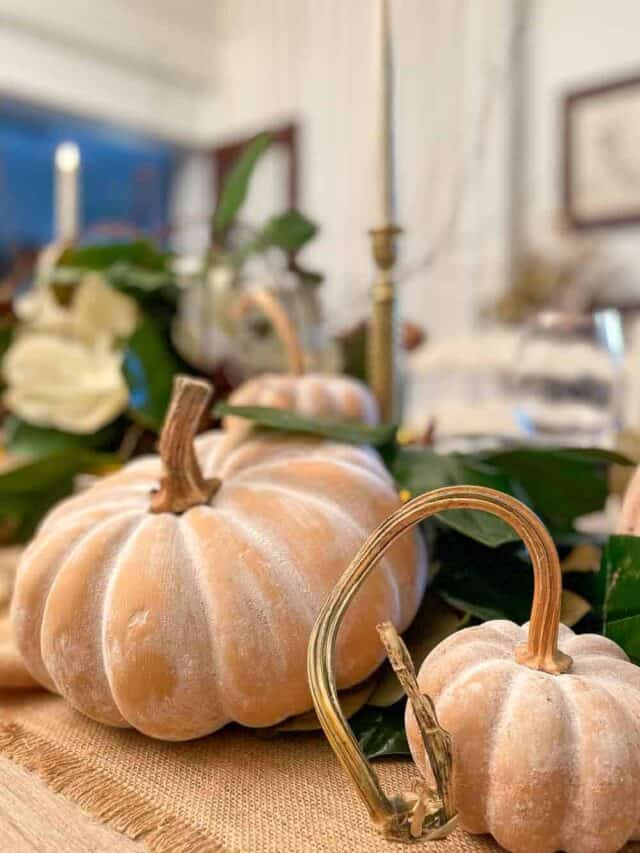
- Fill a dough bowl with pumpkins and display it on your table.

Well, that about wraps it up for me. As you can tell, I have a deep affection for pumpkins and their endless possibilities. I hope I’ve sparked your inspiration to try something new this fall.
Have a great week!




How to Make Easy DIY Fabric Wall Art for Your Home
Adding a pop of color to your walls is a breeze with this easy DIY fabric wall art project.

Best Designer Shelf Styling Tips for Spring
Refresh your space this spring with the best “How to style shelves like a designer”.

A New Adventure: Two Porches and a Pour
Our New Podcast I am beyond excited to share a brand-new adventure with you—a podcast! 🎙️✨ That’s right! My dear friend Lynn (@livinglargeinasmallhouse) and I are launching our very own podcast, “Two Porches and a Pour,” airing every Wednesday! Lynn and I became fast friends years ago when we both started blogging. Over time, our…




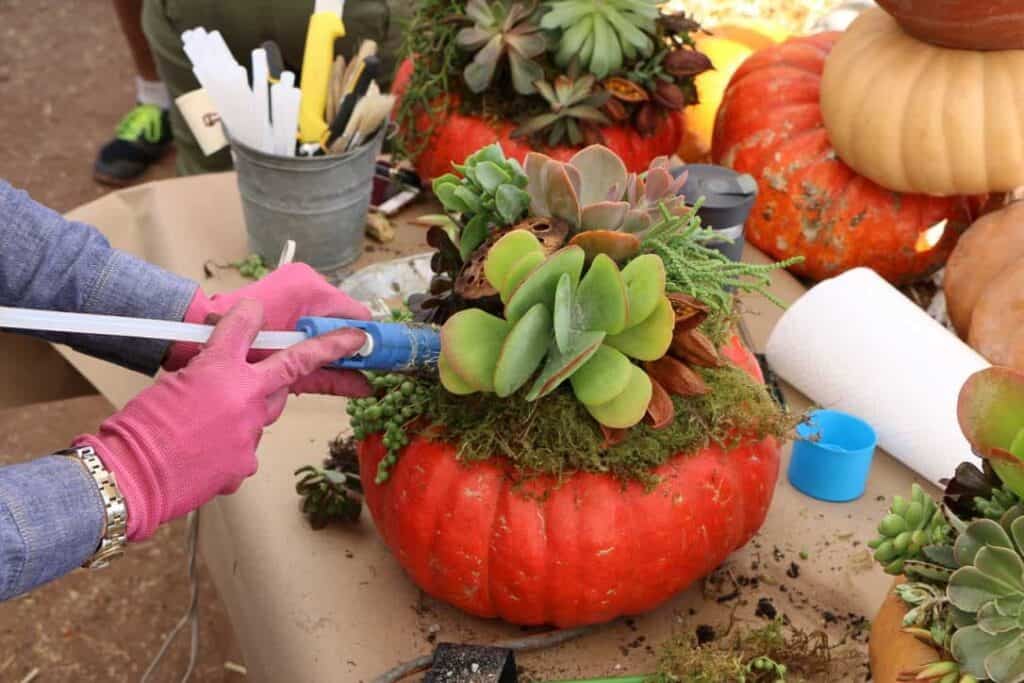
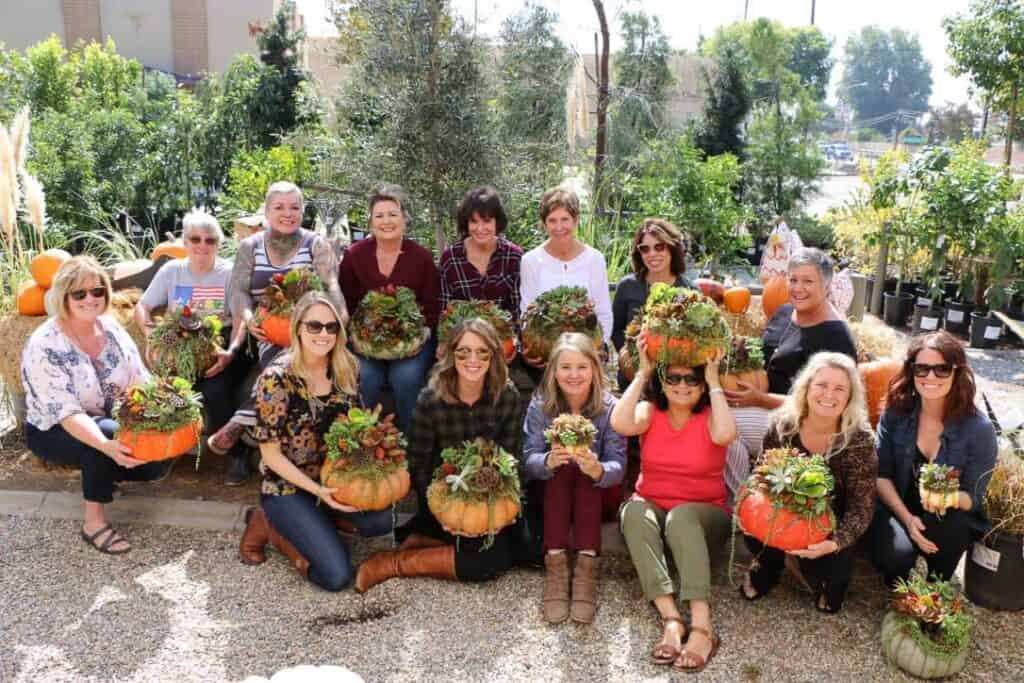



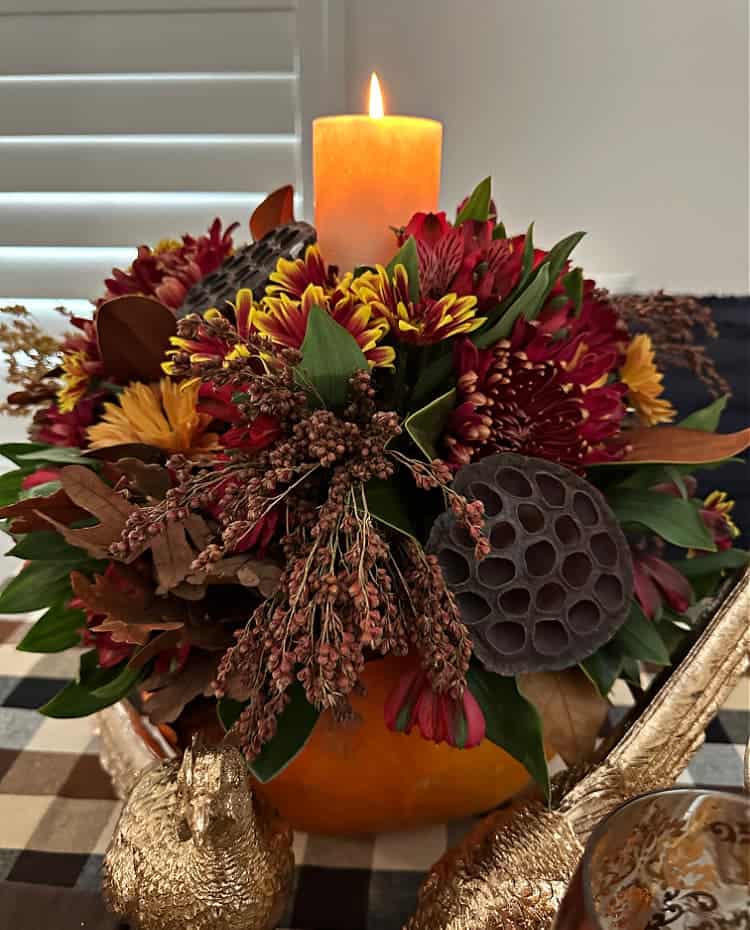


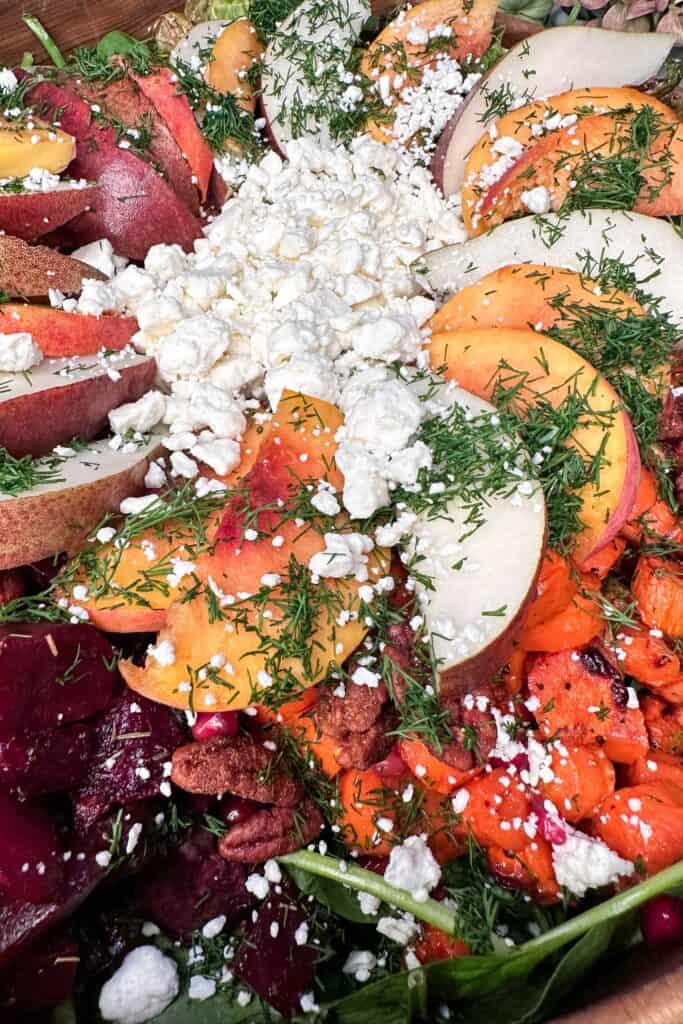
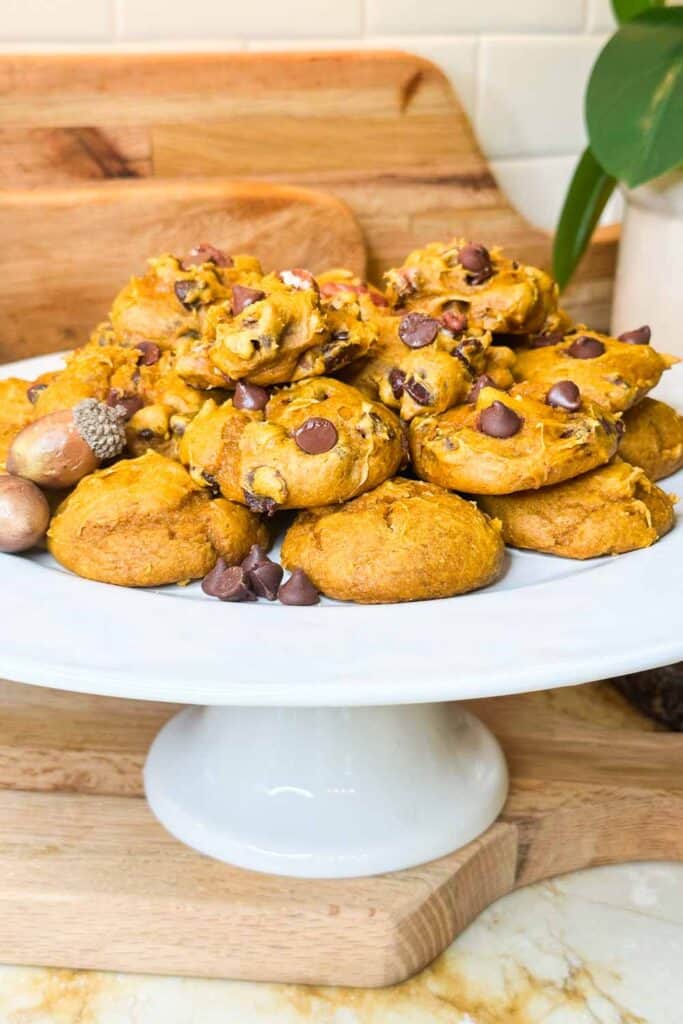






If I had space to grow these, I absolutely would because I think they are so beautiful! Guess I’ll just buy instead! Beautiful post and photos, Wendy!
I had no idea there were so many beautiful ways to use and display Cinderella pumpkins, Wendy. I loved all the ideas you shared. They feel like such a special way to transition from Halloween to Thanksgiving. Hugs, CoCo
Thank you, CoCo. It really is amazing what you can do with a pumpkin!
Oh wow! So cute!!! I’ve never heard of these types of pumpkins, but they are adorable!
It must be mu obsession with pumpkins, lol!
Love learning about the Cinderella pumpkins. They are really hard to find around here. If I do find them, the prices are crazy. One year, I will try to grown some.
Wow, I had never heard of them being expensive. Maybe you need to move to California! now that would be expensive, LOL